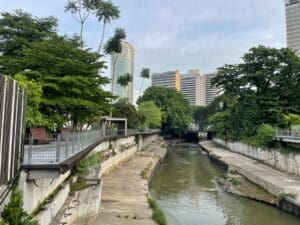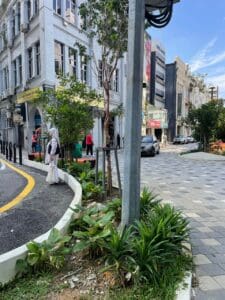Malaysia’s Green Revolution
Towards A Sustainable Urban Environment for Malaysia
by Prof (Rtd) Dr. Shuhana Shamsuddin
& Dr Azlin Abd Jamil
Malaysians, and the rest of the world, the year 2020 was a wake-up call when we started living in a way that kept us from going out and instead kept us inside. Yes, the COVID-19 virus attack!
After four years, things are still not the same as they were before. On the other hand, habits had taken shape as a result of the pandemic. The point is that people’s behavior changed suddenly, and it affected every aspect of their lives, from workplace practices and education to travel, retail and shopping, public spaces, housing, food and dining, events and gatherings, and personal lifestyle choices. We must not forget that the virus has the potential to affect everyone, no matter what their situation is—if you are around infected people, you will almost certainly get infected too!
Shifting of emphasis in design for post pandemic resilience
Prior to the outbreak, most companies, such as Microsoft, Google, and AirAsia, favored open design concepts for their buildings. However, due to the pandemic, they had to restrict employees from being in the office. This highlights the importance of preparing workplaces for such threats. One way to achieve this is by incorporating adaptable and resilient design features so that buildings are prepared for such unexpected issues while ensuring workers remain safe, comfortable, and productive. At the same time, balancing open and closed design concepts can foster social distancing, well-being, and group involvement too! whilst prioritizing flexibility and resilience in urban planning to mitigate public health issues while maintaining the energy and comfort of the workplace.
Furthermore, with proper planning and a focus on urban design that is driven by sustainability and health concerns, we can still build positive, walkable places with plenty of space and opportunity for sports, leisure, and recreation. By prioritising effective design components, Malaysians’ well-being can be enhanced, supporting healthier lifestyles and addressing concerns about obesity rates among both adults and children.
 Integrating Sustainable Urban Design into Malaysia’s Development Plan System
Integrating Sustainable Urban Design into Malaysia’s Development Plan System
There is a need to explore how Malaysia can incorporate principles of sustainable urban design into its existing Development Plan system to create cities that are climate-responsive, people-friendly, and culturally rich. This topic would address the need for robust city planning and design in the face of climate change, dwindling energy supplies, and rapid technological advancement, while also emphasizing the importance of preserving urban heritage and ensuring urban environments are safe, comfortable, and accessible to all.
We should now approach global urbanization in alignment with the Sustainable Development Goals and the New Urban Agenda. Given the importance of addressing climate change, incorporating Water-Sensitive Urban Design is crucial. With traditional energy supplies dwindling and technology advancing rapidly, our city planning and design must be robust to withstand the imminent challenges of climate change.
Where are we now? High hopes for future generations’ well-being are critical if we fail to effectively execute our goals, despite having a fantastic planning system in place through the Development Plan system to direct future development and manage development through the requirement of planning approval for any development. Cities that are people-friendly, climatically responsive and having a local character and identity that would make people proud must be a priority. Urban environment quality should be prioritised in the development control stage where Urban Design guidance is given in order to avoid the degradation of our urban heritage as well as the historic and architectural sites. Sustainable Urban Design must be considered at the development plan level and in its implementations, such as the Structure Plan, Local Plans, and Special Area Plans, to ensure that future cities and their urban environments are safe, comfortable, aesthetically beautiful, accessible to all groups of society, long-lasting, and reflective of the culture of different groups in society.
 Professionals working in the built environment have the chance to promote better collaboration and integration in our communities. To develop more coherent urban environments, conduct extensive study during the design process, avoid “working in silos,” and avoid the ‘Island planning’ technique, thus splitting lots with a road network and impeding contextual integration. Local governments can increase resources to ensure sustainable development; the major goal is to comply with development plan regulations, bylaws, technical requirements, and planning standards, while also emphasising the qualitative side of development control. By embracing specific urban design ideas, strategies, and frameworks, we can contribute to broader planning policies that shape future design of cities. Sustainable Urban Design prioritises urban quality over purely aesthetics and beautification approaches. Shifting the emphasis from purely aesthetics to sustainable urban design can improve urban quality in a long-term and strategic way.
Professionals working in the built environment have the chance to promote better collaboration and integration in our communities. To develop more coherent urban environments, conduct extensive study during the design process, avoid “working in silos,” and avoid the ‘Island planning’ technique, thus splitting lots with a road network and impeding contextual integration. Local governments can increase resources to ensure sustainable development; the major goal is to comply with development plan regulations, bylaws, technical requirements, and planning standards, while also emphasising the qualitative side of development control. By embracing specific urban design ideas, strategies, and frameworks, we can contribute to broader planning policies that shape future design of cities. Sustainable Urban Design prioritises urban quality over purely aesthetics and beautification approaches. Shifting the emphasis from purely aesthetics to sustainable urban design can improve urban quality in a long-term and strategic way.
Ultimately, the success of urban planning depends on their implementation and enforcement. To make development plans a great reality, an efficient and quality-focused development control system is crucial. Therefore, the development control wing of the local authority should be its most important component. We hope that nations like Malaysia will integrate urban design into their urban planning practice like the other developed countries to create more distinctive and environmentally friendly cities.
“The details are not the details. They make the design.” – Charles Eames
Dr. Shuhana, a retired Professor of Urban Design at UTMKL, is an accomplished expert in Environmental Planning and Urban Design. She graduated from Anglian Ruskin University and the University of Nottingham, UK. Dr. Shuhana founded and served as the first President of The Malaysian Urban Design Association (PEREKABANDAR), an NGO dedicated to promoting good urban design in Malaysia. She established the Masters in Urban Design program at UTM Skudai and the MSc. Sustainable Urban Design program at UTMKL.
Currently, she is an Adjunct Professor at Taylor’s University, after two terms at UTMKL. Dr. Shuhana has received several accolades, including an award from the Royal Town Planning Institute UK, and has been featured in exhibitions at MIT and Pusat Sains Negara. Her work includes leading projects such as the Kuala Lumpur Heritage Trail Master Plan and studies for UNESCO World Heritage sites in Malaysia. She specializes in the Identity of Place and is the author of the influential book Townscape Revisited: Unravelling the Character of the Historic Townscape of Malaysia.
Dr. Shuhana, a retired Professor of Urban Design at UTMKL, is an accomplished expert in Environmental Planning and Urban Design. She graduated from Anglian Ruskin University and the University of Nottingham, UK. Dr. Shuhana founded and served as the first President of The Malaysian Urban Design Association (PEREKABANDAR), an NGO dedicated to promoting good urban design in Malaysia. She established the Masters in Urban Design program at UTM Skudai and the MSc. Sustainable Urban Design program at UTMKL.
Currently, she is an Adjunct Professor at Taylor’s University, after two terms at UTMKL. Dr. Shuhana has received several accolades, including an award from the Royal Town Planning Institute UK, and has been featured in exhibitions at MIT and Pusat Sains Negara. Her work includes leading projects such as the Kuala Lumpur Heritage Trail Master Plan and studies for UNESCO World Heritage sites in Malaysia. She specializes in the Identity of Place and is the author of the influential book Townscape Revisited: Unravelling the Character of the Historic Townscape of Malaysia.